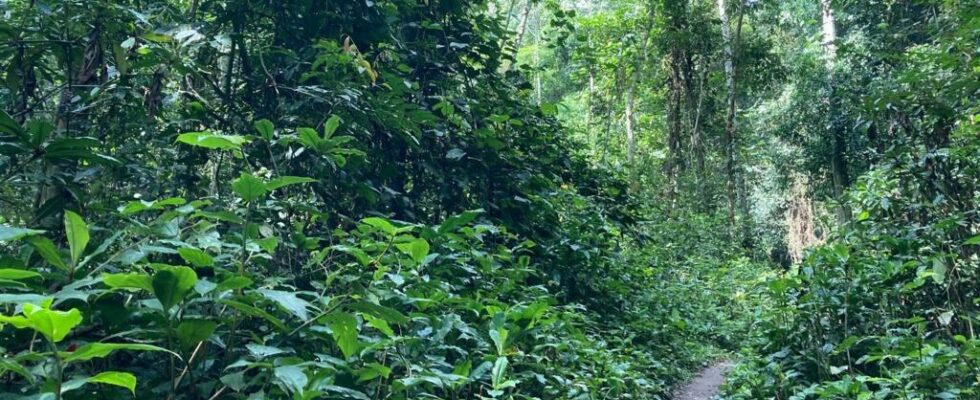It’s a huge job coordinated by the African branch of the WWF: combing through the scientific literature of the last ten years to draw up an inventory of species discoveries over this period. Monkey, crocodile or even coffee, the region confirms its status as a flagship region for biodiversity.
5 mins
It’s a paradox: the majority of them have been known for generations by local communities but their notoriety has never crossed borders. This is the case with the lesula, a species of monkey, which lives in the Lomami park in the Democratic Republic of Congo (DRC). Its local residents frequent it and hunt it for its meat but the scientific community discovers it and is only just beginning to describe its eyes similar to ours and its blue buttocks. “Of course, the people there know the animals and their habitats. But this is much less true in the international world”explains Jaap van der Waarde, head of Congo Basin conservation at WWF International.
“There are scientists who come to the region and publish their research in scientific journals. But it is not always very accessible. We therefore took the initiative of listing these discoveries and presenting them to as many people as possible. » The World Wild Fund (WWF) therefore contacted hundreds of scientists from institutes and universities around the world to carry out this inventory: “New life in the Congo Basin: a decade of species discovery (2013-2023)”.
” Of the ‘hotspots’ incredible diversity »
By reading the 80 pages of this report, we will become acquainted with 430 new species of plants, 140 invertebrates, 96 fish, 22 amphibians, 2 birds and 10 mammals, living in the 6 countries which form the Congo basin: the Cameroon, Central African Republic (CAR), DRC, Equatorial Guinea, Gabon, and Republic of Congo. We will come across the monkey Lesula, therefore, the first new species of monkey described since 1984, but also Afrodiaphanous Pulcher, a Central African firefly, The Swordbearer Emperor, a Congolese dragonfly.
The fish are not left out: in Gabon, Aphyosemion aurantiacum shines brightly with its iridescent blue scales and its intense orange tail and fins. Also, 22 new frogs can now be added to biology textbooks around the world, as well as a new species of crocodile, Mesistops leptorhynchus or slender-snouted crocodile from Central Africa. “The tropical forests of the Congo Basin are ‘hotspots’ incredible diversity, but they are also under great threat of habitat destruction”explains researcher Julian Kerbis Peterhans, cited in the report. “We suspect that dozens of new species are waiting to be discovered. The latter are essential for informed conservation of the tropical forests of Congo”. “We can only protect the things we know”agrees Jaap van der Waarde. “It’s important to know them, to count them, to know their role in the ecosystem, to know whether or not they are in danger. »
In fact, the biologist assumes, like many others, that many species became extinct before even having encountered them. “This is the reality of today’s world. With the WWF, we publish the report every two years ‘Living planet’. The latest revealed that animal populations have declined by 70%. Inside, there are necessarily species that are no longer on this planet.” This is the case of a species of coffee unearthed by Piet Stoffelen, from the Meise botanical garden in Belgium. It was collected in the 1980s in the forests of the Congo Basin and remained unknown for decades, until the work of this report was launched, and has since become extinct. “It’s because of deforestation”explains Piet Stoffelen. “Coffee is a typical undergrowth plant, and this species came from the south-east of Cameroon, where deforestation is very significant. “.
Major environmental pressures
It is for this reason that the entire last part of the report is devoted to the threats weighing on the second lung of the planet and to the means to be implemented to protect it. The Congo Basin is in fact facing major environmental pressures: deforestation, but also mining, poaching and the consequences of climate change.
While there is no need for a reason to refrain from preserving an ecosystem and the species it shelters, Congolese biodiversity can also provide services to communities: 75 million people depend on it for food or housing. . It is also a major part of their cultural heritage. Piet Stoffelen takes the example of coffee: “because of climate change, its culture is threatened. But we can adapt, especially with the species found in wild forests. Those found in the Congo Basin, their genetic resourcesare very well adapted to poor soils. More than those who come from West Africa. We can improve existing crops, adapt them to less favorable conditions and help farmers. »
For this to happen, endemic species of the Congo Basin must still be conserved. The solutions are known: agroforestry, involvement of local communities, fight against poaching… Jaap van der Waarde also highlights FSC certification of harvested timber: “Only 10% of the wood that comes from the basin is certified. However, we know that it works. An article published in the magazine Nature showed that certified and sustainably managed forests are home to many more large mammals than others, and an ecosystem favorable to large animals is favorable to all others. »
